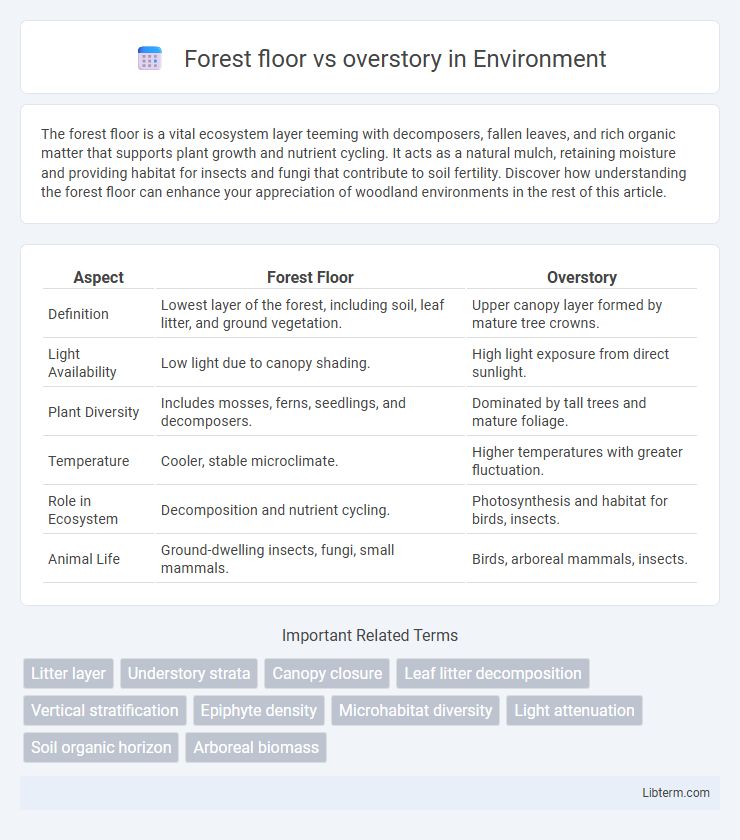The forest floor is a vital ecosystem layer teeming with decomposers, fallen leaves, and rich organic matter that supports plant growth and nutrient cycling. It acts as a natural mulch, retaining moisture and providing habitat for insects and fungi that contribute to soil fertility. Discover how understanding the forest floor can enhance your appreciation of woodland environments in the rest of this article.
Table of Comparison
| Aspect | Forest Floor | Overstory |
|---|---|---|
| Definition | Lowest layer of the forest, including soil, leaf litter, and ground vegetation. | Upper canopy layer formed by mature tree crowns. |
| Light Availability | Low light due to canopy shading. | High light exposure from direct sunlight. |
| Plant Diversity | Includes mosses, ferns, seedlings, and decomposers. | Dominated by tall trees and mature foliage. |
| Temperature | Cooler, stable microclimate. | Higher temperatures with greater fluctuation. |
| Role in Ecosystem | Decomposition and nutrient cycling. | Photosynthesis and habitat for birds, insects. |
| Animal Life | Ground-dwelling insects, fungi, small mammals. | Birds, arboreal mammals, insects. |
Introduction to Forest Structure
The forest floor comprises decomposing leaves, organic matter, and soil organisms, playing a crucial role in nutrient cycling and seedling development. The overstory consists of the tallest trees forming the canopy layer, which regulates light penetration and microclimate within the forest. Understanding the contrast between the forest floor and overstory is essential for studying forest structure and ecosystem dynamics.
Defining the Forest Floor
The forest floor, constituting the lowest layer of a forest ecosystem, is characterized by soil, decomposing organic matter, and understory vegetation such as seedlings, shrubs, and fungi. This layer plays a crucial role in nutrient cycling, moisture retention, and providing habitat for diverse microorganisms and invertebrates that contribute to forest health. In contrast, the overstory comprises the tallest trees forming the canopy, which regulates light penetration and protects the forest floor from extreme weather conditions.
Understanding the Overstory Layer
The overstory layer consists of the tallest trees forming the forest canopy, playing a crucial role in regulating light penetration and microclimate for the underlying forest floor. This layer influences photosynthesis rates, biodiversity, and nutrient cycling by controlling temperature, humidity, and light availability. Understanding overstory dynamics is essential for forest management and ecological conservation, as it significantly impacts habitat structure and ecosystem productivity.
Key Differences Between Forest Floor and Overstory
The forest floor consists of the lowest layer in a forest ecosystem, dominated by soil, decomposing organic matter, and shade-tolerant plants, serving as a critical zone for nutrient cycling and seedling growth. The overstory forms the uppermost canopy layer, comprised mainly of mature, tall trees that regulate light penetration, influence microclimate conditions, and provide habitat for numerous wildlife species. Key differences between the forest floor and overstory include light availability, species composition, and ecological functions, with the overstory primarily responsible for photosynthesis and energy capture, while the forest floor focuses on decomposition and nutrient recycling.
Biodiversity in the Forest Floor vs Overstory
The forest floor hosts a rich biodiversity of fungi, plants, and invertebrates critical for nutrient cycling and habitat complexity, while the overstory supports a diverse assemblage of bird species and arboreal mammals adapted to canopy life. Microhabitats in the forest floor, such as leaf litter and decomposing wood, provide unique ecological niches, contrasting with the overstory's vertical stratification that influences light availability and microclimate. Biodiversity patterns in these layers are interconnected, with the overstory influencing understory conditions and the forest floor contributing to overall forest ecosystem resilience.
Light Availability and Microclimate
The forest floor receives limited light availability due to canopy cover from the overstory, resulting in lower photosynthetically active radiation essential for understory plants. The overstory modulates the microclimate by reducing temperature fluctuations and maintaining higher humidity levels on the forest floor compared to open environments. This interplay creates a cooler, moister microhabitat that supports diverse shade-tolerant species and influences nutrient cycling processes.
Nutrient Cycling and Soil Composition
The forest floor plays a crucial role in nutrient cycling by decomposing organic matter, which enriches soil composition with essential nutrients like nitrogen, phosphorus, and potassium. Overstory vegetation influences soil composition indirectly through leaf litter fall, root exudates, and canopy interception, affecting moisture retention and microbial activity. Together, forest floor and overstory interactions regulate nutrient availability and soil fertility, supporting forest ecosystem productivity and biodiversity.
Wildlife Habitat and Adaptation
The forest floor provides critical wildlife habitat by offering shelter, foraging grounds, and breeding sites for small mammals, amphibians, and ground-nesting birds, facilitating species adaptation to low light and high moisture conditions. The overstory supports arboreal wildlife and larger birds that depend on canopy cover for nesting, feeding, and protection from predators, influencing adaptation to vertical space and variable climate exposure. Together, these layers create a vertical stratification essential for biodiversity, enabling diverse species to occupy distinct ecological niches and optimizing ecosystem resilience.
Human Impact on Forest Floor and Overstory
Human activities such as logging, agriculture, and urban development significantly alter the forest floor and overstory by reducing biodiversity and disrupting nutrient cycles. The removal of overstory trees increases sunlight penetration, leading to soil erosion and changes in understory vegetation composition on the forest floor. Pollution and invasive species further degrade both layers, impairing forest regeneration and ecosystem services essential for carbon sequestration and habitat stability.
Conservation and Management Strategies
Forest floor conservation efforts prioritize protecting soil integrity, organic litter, and understory biodiversity critical for nutrient cycling and habitat quality. Overstory management strategies focus on sustaining mature tree populations to ensure carbon sequestration, canopy cover, and microclimate regulation. Integrating forest floor and overstory practices enhances ecosystem resilience and supports long-term forest health in conservation programs.
Forest floor Infographic

 libterm.com
libterm.com